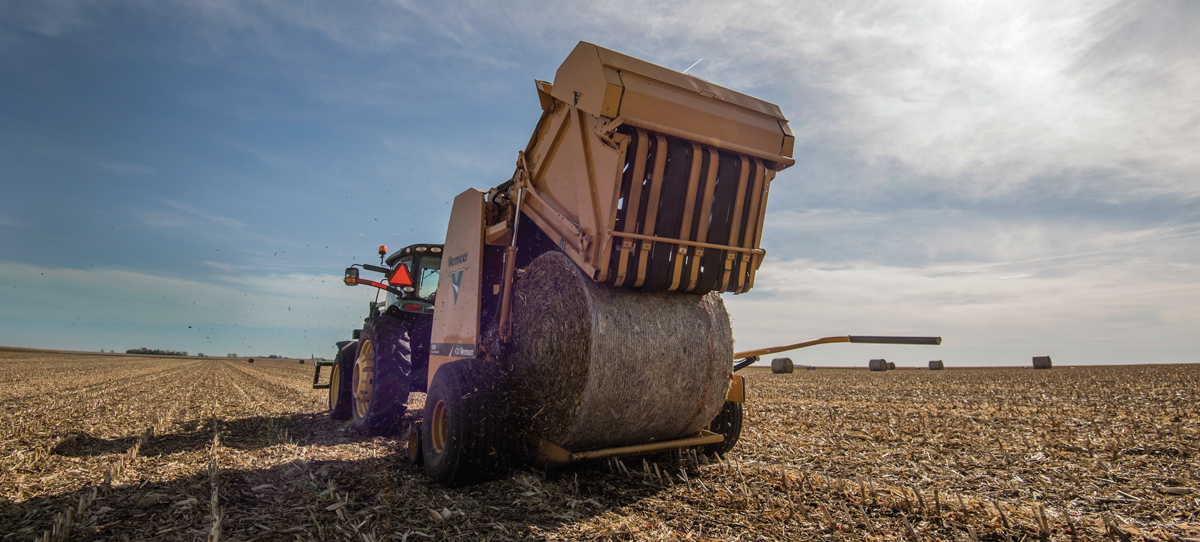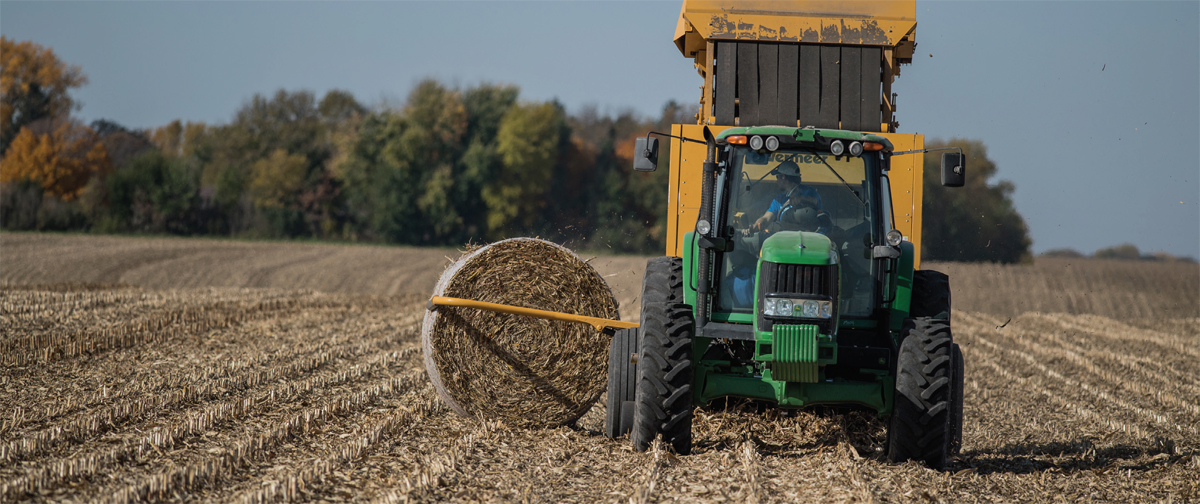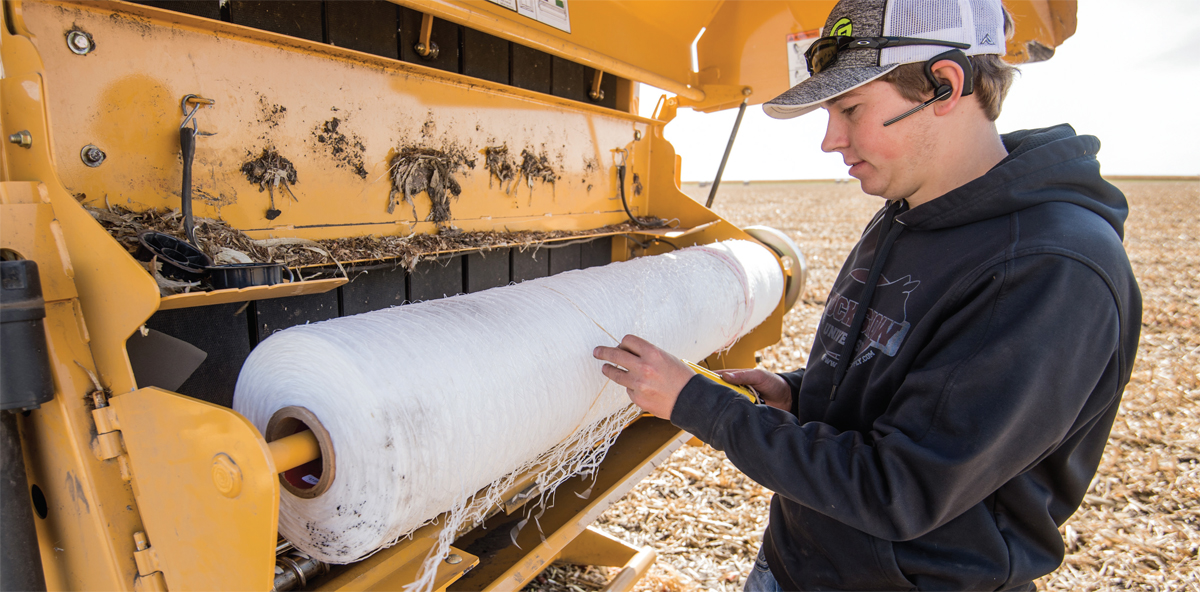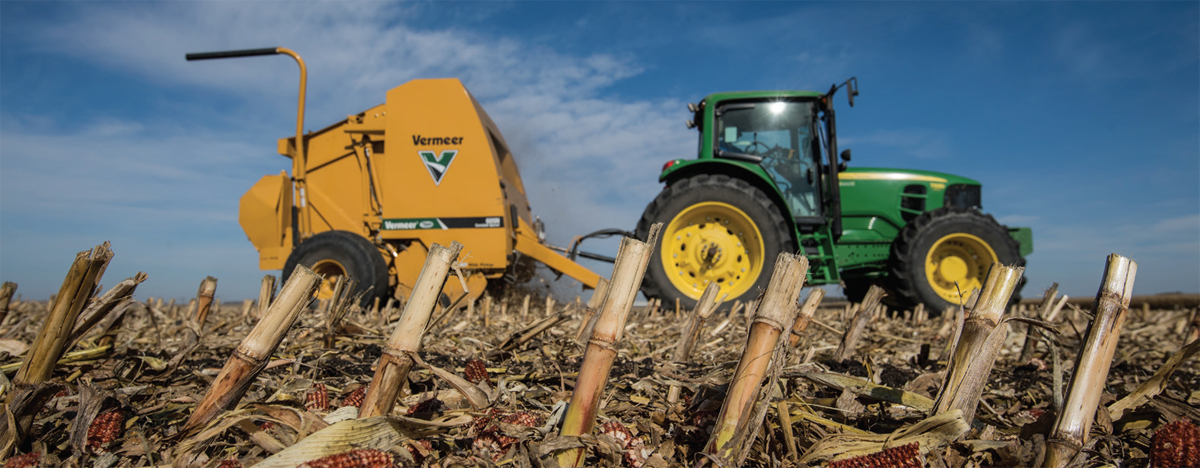The corn stover harvest is about to get much larger in the counties surrounding Emmetsburg, Iowa, as production gains momentum at Project LIBERTY — POET-DSM Advanced Biofuel’s 20 million gallon cellulosic biofuels plant. “We’ll be increasing the acres and our custom base by 50 to 60 percent,” said Allan Keller, Plant Biomass Manager, POET. The stover harvest — which removes a portion of the residue left after combining field corn — is bringing new economic opportunity to the area as growers are paid for the collected biomass and others get involved in baling and transporting the big bales for processing at the plant. The goal is economic, environmental and social sustainability.
Producers who have participated in multiple stover harvests report positive experiences. “I’m a big fan of it,” said Justin Eichelberger, who farms 40 miles south of Emmetsburg at Manson. “You don’t have [residue] blowing away or washing away if you have a flood. It doesn’t block up our field cultivator when trying to go through corn stalks. And you can make a few bucks doing it.”
“We’re not taking a tremendous amount of stover off,” said Bruce Nelson, who farms a few miles north of Emmetsburg. “Typically we have 4 to 5 tons of biomass in the field after harvesting the grain, and we’re baling 1 ton.”
Based on earlier research, POET recommends 1-ton removal as a sustainable level. After the bales are off the field, one can hardly tell which corn fields were baled and which weren’t, Nelson said.
One side benefit for Nelson’s operation has been eliminating one tillage pass across the farm on corn acres. On one part of the farm in particular, with plenty of rocks and rolling ground, stover removal has meant tillage could nearly be eliminated, Nelson said. He reports minor impact on nitrogen and phosphorus levels from stover removal; however, potassium replacement has increased.
Brandon Miner’s experience illustrates another benefit of the biomass program: creating jobs and business opportunities. Miner helps his dad farm 12 miles west of Emmetsburg at Ruthven. He holds a full-time job and has a small cattle operation. Beginning five years ago, he used his round hay baler to roll up his acres, along with a few neighbors. Since then, he’s added two balers and started a sideline business in the fall. “It’s given me an opportunity to build some equity,” he said.
The other two growers have new sideline businesses as well. Nelson and a friend have created some fulltime and a number of part-time jobs, he reported, doing custom baling and hauling. Eichelberger and a friend also provide baling services around their community.
“We take pride in not taking too much off,” Eichelberger said. “We don’t want to run dirt and rock through our balers, and I know people don’t want dirt showing.”
Learning POET’s protocol for harvest sounds more complicated than it is, he said. The chopper/ spreader on the combine is turned off and the stover dropped into a windrow to be baled without raking. As new growers are recruited, some express concern, he added. “I don’t think the people around Manson are that nervous about taking stover off. They’re more nervous that the bales are going to sit there a long time.”
Nelson concurred. With the commissioning challenges faced at the first-of-its-kind plant, some didn’t get those bales moved for several months. “If a guy has a Type A personality, it could really bother him,” Nelson said. He’s been a supporter of Project LIBERTY from the beginning, even working with some of the early prototype harvests. This fall will be the eighth season Nelson and his farming partners, his dad and uncle, have contracted their corn acres.
The stover harvest has progressed, Nelson said. Today the backlog of bales on farmers’ fields has been eliminated. “Everyone had troubles at first, from the producer to POET, to the custom guys, but along the way there’s a lot of answers that have come with experience.”
Biomass harvesting takes place in October 2017 on Craig Brownlee’s land in Emmetsburg, Iowa.
For example, Nelson mentioned he has gained a better understanding of where to site field stacks, better systems for hauling and unloading bales, and the big one: “Now that the plant is running better, it makes it easier to schedule when to bring the product in.”
Keller explained POET’s goal is to have the stover harvested and the bales moved off the field within a week of the grain harvest being completed.
“We usually are underneath that,” Keller said. “We utilize in-the-field storage until the bales are needed at the plant. Some are picked up real soon, and some stay out there 12 months — our pay structure is set up to reflect that.”
He acknowledged the hiccups at the plant preventing timely deliveries was a problem at first. “But the mood is drastically improving in the past few months. The plant is steadily going through material and the thought process is changing to, ‘Can we do more acres?’” he said. “This will be our biggest harvest, but we fully anticipate filling all our contracts.”
POET has developed its model for biomass contracts with flexibility, Keller continued. “We try to allow farmers to be as involved as they want to be.” Producers can do their own baling and delivery, make their own custom arrangements or, if they prefer, have POET’s team handle all the logistics. Payment reflects how much of the work they do. “Most of our customers are receiving between $15 and $35 net per acre,” he said. “The guys doing it themselves are making the most money, because they are managing the process.”
Nick Moiser changes the bale netting.
As POET’s biomass team members meet with farmers to explain the program and describe POET’s protocols for baling, they occasionally call upon one of the researchers involved early on in determining how much residue removal would be sustainable.
Douglas Karlen, Research Soil Scientist with the United States Department of Agriculture Research Service based at Iowa State University, tells any group he talks to that, as a soil scientist, “my first priority is to take care of the soil. If you take care of the soil, the soil will take care of us. That’s the ground rule.”
“Many of those producers are encountering residue management problems,” he explained. He doesn’t recommend increasing tillage to manage the residue, because that could disturb the root-zone carbon. “Intensive tillage really burns up the organic matter imbedded in the soil,” he said. He suggests producers consider sustainable stover removal instead. It not only helps with equipment interference in the following crop plant, but less ground cover means soils warm more quickly in the spring, which in turn aids germination and field stands.
Biomass harvesting takes place in October 2017 on Craig Brownlee’s land in Emmetsburg, Iowa.
POET’s approach to harvest corn residue has been conservative, Karlen said. “The target is 1 to 1.5 tons per acre and for the yields in the supply shed they’re working in, it is well within the guidelines of sustainability, even if the producer doesn’t want to reduce tillage. But I think they will find they can reduce tillage intensity.” When done right, there will be sufficient plant residue left on the soil to sustain and even slightly increase organic matter, he said.
In talking about future sustainability and biomass harvests, Karlen said he can envision a time when perennial grasses will be deployed on degraded land or steep slopes. The corn stover harvest for ethanol is the first step in creating market demand for advanced biofuels and biochemicals that will call for additional biomass, he said.
“The bottom line is we must have a long range vision to use the land sustainably, with greater diversity. It’s not only good from the energy perspective, but it’s good economics for the individual producer, for the community and the environment.”











